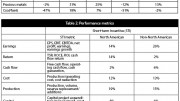The following is an edited except from Société Générale and Thomson Reuters GFMS’s Global Hedge Book Analysis Q3 2014.
By early November 2014 the gold price had fallen by 13% from end of June to a four-year low on Nov. 5. With it, gold-mining equity indexes had also fallen to further lows, with the Philadelphia Gold and Silver Index and NYSE Arca Gold BUGS Index both down around one-third. Market commentators were asking how sustainable these kind of prices could be, and whether the cost of production could put a floor under gold prices. But by the time prices had fallen this low, we were already viewing a mining industry in a fundamentally unhealthy state, with projects shelved, exploration expenditure cut back and sustaining capital being thrifted or deferred where possible.
We argue that these effects will become more severe if prices fall further, towards the US$1,100 mark. At this level, 60% of the industry would be loss-making on an all-in basis, with the current industry average (excluding writedowns) estimated at US$1,200 per oz., and falling. While this certainly does not mean that this amount of production will automatically be shuttered, it does give an indication of the extent to which the industry is required to draw on cash or credit facilities. Falling by-product credits, such as silver and copper (down approximately one-third and 10%, from the 2013 average) have added to producers’ current malaise. A further fall in prices down to, for example, US$1,000 for multiple quarters, would exacerbate the problems facing the industry. In that event we would expect a more marked response to cutting production, with high-cost assets suspended.
Faced with such an environment, should producers hedge? That is a question reserved for the management teams of each specific company to judge according to their circumstances. Instead, we ask the question: “Will gold mining companies hedge?”
While prices remain in a range of US$1,150 to US$1,300, we think we will only see a limited pick up in new producer hedging primarily among those producers that are finding cost-cutting success. That will ensure a positive margin can be locked in, potentially securing the means for project expenditure or acquisitions in the event of an upturn. Producers will focus more on cost-cutting than preserving the price component of margin. Among producers in the upper quartile of the cost curve, for which it could be thought most “needed” price protection, a hedge at a time of severe margin pressure could lock in very thin margins.
But outside simple forward sale hedges, producers can purchase downside protection in the form of put options. In recent years this has most frequently been structured in the form of costless collars whereby producers sell call options to fund the purchase cost of the puts. At times this form of protection can become relatively expensive. Once gold had fallen in early November by 7%, the 20-day volatility rose concurrently up towards 18%. This, coupled with a broadly negative investor positioning, made puts costly at the time when gold was reaching four-year lows. When structured into a costless collar structure, either more protection had to be given up or a lower strike price for the sold calls would of had to be negotiated, lessening the flexibility of those structures with regards to potential price upside, and therefore detrimentally altering the risk-reward equation for producers. There are ways of structuring a hedge using a combination of options to reduce the premiums paid for certain levels of downside protection, depending on the mining company’s views of price risk. However, among the suite of hedged producers we track in this report, this approach is not widely employed, with simple forward sales and bought put/sold call collar structures most prevalent.
Weighing against new hedging, since 2009 a low contango due to low interbank interest rates has provided an opposing force to new strategic hedging being put in place, especially for U.S. dollar and Australian dollar contracts (the majority of the hedge book). In the absence of any attractive premium to spot through securing a higher forward rate (in times of good contango), this focuses the question on what the rationale for hedging is. To hedge in the absence of premium has come to signify that a producer believes the price will fall.
Lastly, we should address sentiment. We have written extensively in the past about management and shareholder opposition to hedging, and we expect that sentiment to remain in the near-term, although our perception is that this is moderating.
So to conclude, if prices do not fall below US$1,200 for an extended period we would not expect a widespread return to hedging within the next three to six months, as there will not be enough pressure to hedge as long as producers continue with cost efficiency exercises and the price effectively trades sideways. If prices were to fall sharply below US$1,200, our view is that only producers at the lower end of the cost curve will be in a position to “safely” hedge. If combined with increasing interest rates and therefore a growing contango, this could strengthen the case for hedging, and the probability that more producers may move to put contracts in place, but it is unlikely rates will move enough in the short- to medium-term to tease out large volumes of hedging. In this scenario we do not, however, expect large-scale hedging to become widespread in the industry. Instead we would look for a more measured and modest uptrend compared to historical levels.



Be the first to comment on "Commentary: Gold producer hedging in a lower price environment"